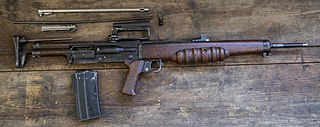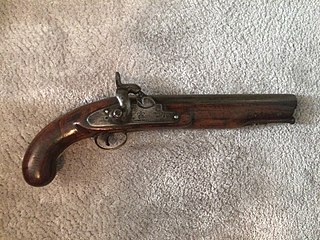
The Krag–Jørgensen is a repeating bolt-action rifle designed by the Norwegians Ole Herman Johannes Krag and Erik Jørgensen in the late 19th century. It was adopted as a standard arm by Norway, Denmark, and the United States. About 300 were delivered to Boer forces of the South African Republic.
The Krag–Petersson was the first repeating rifle adopted by the armed forces of Norway and was one of the first repeating rifles to be adopted as standard issue by a military force, being preceded by the Swiss Vetterli adopted in 1867. Developed by Ole Herman Johannes Krag, the action of the Krag–Petersson was uniquely actuated by an oversized hammer. Another distinguishing feature was that the cartridge rising from the magazine was not seated automatically, but had to be pushed into the breech of the rifle.

The EM-2, also known as Rifle, No.9, Mk.1 or Janson rifle, was a British assault rifle. It was briefly adopted by British forces in 1951, but the decision was overturned very shortly thereafter by Winston Churchill's incoming government in an effort to secure NATO standardisation of small arms and ammunition. It was an innovative weapon with the compact bullpup layout, built-in carrying handle and an optical sight.
The Kammerlader, or "chamber loader", was the first Norwegian breech-loading rifle, and among the first breech loaders adopted for use by an armed force anywhere in the world. A single-shot black-powder rifle, the kammerlader was operated with a crank mounted on the side of the receiver. This made it much quicker and easier to load than the weapons previously used. Kammerladers quickly gained a reputation for being fast and accurate rifles, and would have been a deadly weapon against massed ranks of infantry.
The Sturmgewehr 57 is a selective fire battle rifle designed by Schweizerische Industrie Gesellschaft of Switzerland. The Stgw. 57 assault rifle uses a roller-delayed blowback system similar to the blowback system of the Heckler & Koch G3 and CETME rifles. As an assault rifle, the model AM 55 entered service in the Swiss Army in three designations F. ass. 57 7.5mm and 7.5mm Stgw. 57. Technologically, the Stgw. 57 was the mechanical and design basis for the export-variations of the SG 510 family of small arms. After thirty-three years, from 1957 to 1990, the Swiss Army replaced the Stgw. 57 with the SIG SG 550, a lighter-weight assault rifle.

A service rifle is a rifle a military issues to its regular infantry. In modern militaries, this is generally a versatile, rugged, and reliable assault rifle or battle rifle, suitable for use in nearly all environments and is effective in most combat situations. Almost all modern militaries are issued service pistols as sidearms to accompany their service rifles. The term can also be used to describe weapons issued by non-military forces, such as law enforcement or paramilitaries.
6mm XC is a rifle cartridge, similar to the 6x47mm Swiss Match.

The origins of the modern British military rifle are within its predecessor the Brown Bess musket. While a musket was largely inaccurate over 100 yards (91 m), due to a lack of rifling and a generous tolerance to allow for muzzle-loading, it was cheap to produce and could be loaded quickly. The use of volley or mass firing by troops meant that the rate of fire took precedence over accuracy.

The Enfield Pattern 1853 rifle-musket was a .577 calibre Minié-type muzzle-loading rifled musket, used by the British Empire from 1853 to 1867; after which many were replaced in service by the cartridge-loaded Snider–Enfield rifle.
The SG 550 is an assault rifle manufactured by SIG Sauer AG in Switzerland. "SG" is an abbreviation for Sturmgewehr. The rifle is based on the earlier 5.56×45mm NATO SIG SG 540.
The Eidgenössischer Stutzer 1851, also called Feldstutzer 1851, was the first service rifle used by the Swiss armed forces to be procured by the federal government, which was responsible for the armament of the Cantonal armed forces under the 1848 federal constitution. It was also the first military weapon in Europe to use the smaller 10.5 mm caliber instead of the prior de facto standard of 18 mm.
The Jägergewehr 1856/59, originally designed in 1853, was intended to be a service rifle for use by the Swiss armed forces. It was one of the first pure infantry weapons to feature a rifled barrel. However, by the time all 14,000 procured weapons were delivered in 1860, they were already perceived as obsolete and were never issued to the troops.
The Infanteriegewehr 1863 was the first Swiss army service rifle to feature a rifled barrel. Like other Swiss infantry weapons of the period, it was retrofitted with a Milbank-Amsler breechloading system from 1867 on.
The Vetterli rifles were a series of Swiss army service rifles in use from 1869 to 1889, when they were replaced with Schmidt–Rubin rifles. Modified Vetterlis were also used by the Italian Army.

A pistoleer is a mounted soldier trained to use a pistol, or more generally anyone armed with such a weapon. It is derived from pistolier, a French word for an expert marksman.
The Springfield Model 1847 was a percussion lock musketoon produced by the Springfield Armory in the mid-19th century.
A needle gun is a firearm that has a needle-like firing pin, which can pass through the paper cartridge case to strike a percussion cap at the bullet base.

The US Model 1842 Musket was a .69 caliber musket manufactured and used in the United States during the 19th century. It is a continuation of the Model 1816 line of muskets but is generally referred to as its own model number rather than just a variant of the Model 1816.

Eidgenössische Schützenfeste are the Swiss federal shooting competitions organized by the Schweizerischer Schützenverein since 1824.








